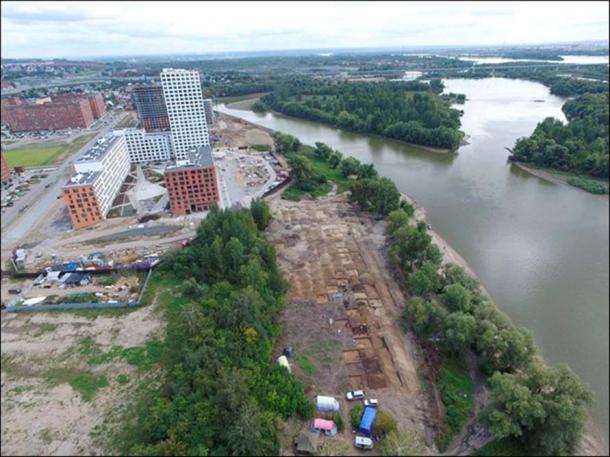
Unique 5,000 Year Old Figurine with Feather Headdress Found in Old Potato Field
By Anna Liesowska
'Absolutely stunning' ancient ornaments were discovered with no known comparisons, presenting a puzzle for archaeologists: which culture made this? The finds were made on a pre-historic burial site Turist-2 close to the east bank of the Ob River in Novosibirsk. The most sensational is a figurine made of an as yet unknown organic material featuring what appears to be a feather headdress.

Dr Natalia Basova holds a figurine with a feather headdress. Picture: Institute of Archaeology and Ethnography SB RAS
Or could it be a halo atop the head of a deity?
Researchers will now work hard to decipher the meaning of this intriguing relic.
- Another Venus? Rare Neolithic Female Figurine Discovered in Turkey
- Ancient dogu figurines with large goggle-eyes defy scholarly explanation


Neolithic and late Bronze Age settlements were found on the location of an old potato field. As were a Bronze Age burial site and a single burial from Turkic time. Pictures: Institute of Archaeology and Ethnography SB RAS, NGS.ru
Feather headgear is not common in archaeological sites in ancient Siberia - although they were in the Middle East perhaps one or two thousand years later - and leading archaeologist Vyacheslav Molodin has called this and other finds 'absolutely unique'
Head of the expedition, Dr Natalia Basova, outlined other unexpected finds.
'We found a figurine of a bird made of bone, and most likely it was sewn onto clothes or was a kind of pendant,' she said.
'There were four anthropomorphic figurines, made of mammoth tusk, sandstone, birch burl and an unknown organic material, which needs to be checked.


The figurine was made of an as yet unknown organic material. Pictures: Institute of Archaeology and Ethnography SB RAS
‘The anthropomorphic figurines were most likely sewn onto clothes as they have holes. There is also a figurine of a moose, made of shale, but we are not sure if we can attribute it clearly. We found the figurine in the wall of an excavation hole, not in a burial. This figurine is now restored and was probably used for 'ritual purposes', she said.
In male burials, archaeologists uncovered belt buckles made of bone and small sculptures, including anthropomorphic artifacts.
- Fascinating Figurines Accompanied a Chinese General and his Princess Wife to the Afterlife
- The Nampa Figurine: 2-million-year-old Relic or Just a Hoax?

Anthropomorphic figurine made of mammoth tusk. Picture: Institute of Archaeology and Ethnography SB RAS
The preliminary dating of the site is up to the end of the third millennium BC, but stone implements were found from the Neolithic Age, possibly as old as the fourth millennium BC.
A late Bronze age settlement of the Irmen culture and a medieval burial from Turkik times were found too.
The main ancient burial ground is probably from the Krotovo culture from the middle Bronze Age, but the experts want more time to assess.
The finds are likely to make their way to Russia's premier museum, the St Petersburg Hermitage.
Professor Molodin said of the figurines: 'The finds are absolutely unique. This is most likely the third millennium BC.’

Figurine of a bird made of bone, most likely it was sewn onto clothes or was a kind of pendant. Picture: Institute of Archaeology and Ethnography SB RAS
'According to the iconography of images, they are similar to the Okunev or Samus culture. But the first did not reach our territories, and the second has a completely different funeral rite. By funeral practice, this is without a doubt Krotovo culture.’
There are no parallels to the objects that have been found.
'They are absolutely stunning and, without exaggeration, worthy of the St Petersburg Hermitage Museum.’



'By funeral practice, this is without a doubt Krotovo culture.' Pictures: Institute of Archaeology and Ethnography SB RAS
'I am sure that experts will examine them more than once.'
- World Famous Ancient Siberian Venus Figurines are NOT Venuses After All
- The Immense Collection of Strange Acambaro Figurines: Evidence of Dinosaurs Living Among Us?
The excavations are more complex because the natural layering of the soil was disturbed by a giant wave that washed over the site - called Tourist-2, some 4,000 years ago. This was caused by an earthquake, geologists say.
In more modern times it was a potato field, before soil was removed to 'beautify the city'.
The debris from construction sites was dumped here. The river was also dredged, and the silt put on this site.
Top Image: The figurine was made of an as yet unknown organic material. Source: Institute of Archaeology and Ethnography SB RAS
The article, originally titled ‘Unique 5,000 year old figurine with feather headdress found in old potato field in Novosibirsk’ originally appeared on The Siberian Times and has been republished with permission.















